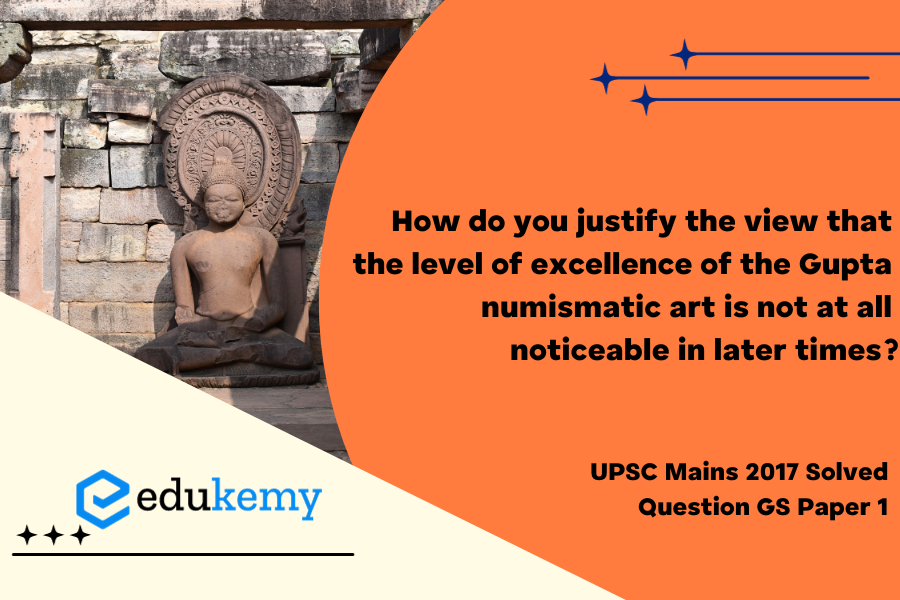The Gupta period in ancient Indian history, spanning from the 4th to the 6th century CE, is widely regarded as a golden age marked by remarkable achievements in various fields, including art, literature, and numismatics. The Gupta numismatic art, in particular, is often celebrated for its exceptional craftsmanship, intricate designs, and the use of high-quality materials. However, as time progressed, the level of excellence that characterized Gupta numismatic art seems to have waned, giving rise to a perception that later periods failed to reach the same heights of artistic prowess. This viewpoint is grounded in an analysis of the artistic evolution of Indian coinage, where the Gupta era stands out as a pinnacle of numismatic brilliance, raising questions about the subsequent periods and their ability to sustain or surpass such artistic excellence.
Tag: Gupta numismatic art, Art and culture.
Contents
Decoding the Question:
- In the Introduction, try to write the status of art and culture in the Gupta age briefly. Why is it called the ‘golden age’.
- In Body,
- Write briefly about Coinage and its features.
- Also, write Coinage of post-Gupta age.
- In Conclusion, try to write an assessment of Coinage of Gupta age and Post Gupta age.
Answer:
Numismatics is the study or collection of coins and currency. It’s among the crucial tools for the archaeologists and historians seeking information of trade, economy, religion, society and personages in a particular area.
The Gupta dynasty ruled around the early 4th century to 6th century C.E. Renowned for their gold coins, and the Gupta numismatic art has a plethora of coins in an array of designs. They also distributed silver coins. However, coins made of copper, bronze or any other alloy metals were limited. This plethora of gold coins from the Gupta era has led some scholars to regard their reign as the ‘rain of gold.

Excellence of the Gupta Numismatic Art:

- The Gupta gold coins are acknowledged as Dinars, and they are the most extraordinary examples of numismatic and artistic excellence.
- Gupta coinage attained the height of metallurgy and iconography. Being indigenous, they portrayed the king, queen, and deities with Indian attire and with lots of grace.
- The coins had the following features and themes:
- Royal themes: Image of king and queen involved in various ceremonies. For example, coins depicting Chandragupta I and queen Kumaradevi etc.
- Themes depicting valor: Samudragupta carrying an axe, bow and arrow, standing with a dagger, Skanda Gupta sitting on an elephant and hunting a tiger in one of the coins.
- Religious themes: Image of a female goddess in almost every coin, an image of the king holding an animal at the altar for sacrifice, ruler performing Ashwamedha Yajna.
- Cultural themes: King Samudragupta playing the Veena.
Coinage of Post Gupta age: Post Gupta age, we find a decline in numismatic art. Coins were rare during the period 900 A.D-1200 A.D.
- The continuous internal feuds among medieval kings had kept their kingdoms fragmented and treasury in poor state. Hence coins were minted in metal of inferior quality- usually nickel, copper and lead.
- Dynastic coins were minted and demonetized in haste because of frequent coups and succession. For example:Rajput coin designs were confined to martial motifs of bull and horseman type.
- The prohibition of idolatry in Islam severely limited the scope of inscribing motifs and images in the coins of Delhi sultanate and Mughal empire. Usually these coins bore only textual information such as the name of the king and date of issue.
- The weakening of the Mughal empire and subsequent fall of land revenue had forced Aurangzeb to debase his coins. The subsequent reduction in the content & quality of metal had further reduced the scope of border designs, luster and premium look- even in the coins of highest denomination.
- British-Indian coins were monotonous in design as they had textual information of coin denomination and year on the obverse side and portrait of the king or queen on the reverse side. After independence, the king’s portrait was replaced by the Lion Capital of the Ashoka Pillar and other indigenous motifs of sovereignty and freedom.
Thus, with the aforementioned observations of dynastic coins in the Northern, Southern and Western kingdoms of Medieval India, we can conclude that the level of excellence of Gupta numismatic art is unparalleled in the history of Indian coinage.The Gupta period is treated as the “Golden Age” of classical India. The flourishing state of the economy was ascertained by a large number of gold coins circulated by different Gupta rulers.
In case you still have your doubts, contact us on 9811333901.
For UPSC Prelims Resources, Click here
For Daily Updates and Study Material:
Join our Telegram Channel – Edukemy for IAS
- 1. Learn through Videos – here
- 2. Be Exam Ready by Practicing Daily MCQs – here
- 3. Daily Newsletter – Get all your Current Affairs Covered – here
- 4. Mains Answer Writing Practice – here


